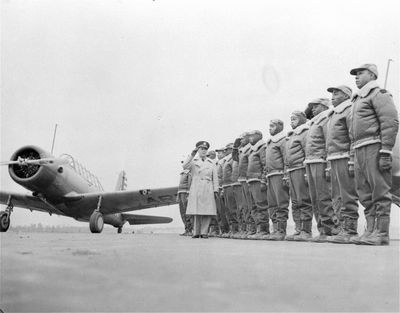Pentagon identifies Tuskegee Airman missing from World War II

The Defense Department announced Friday that it has accounted for the first of more than two dozen black aviators, known as Tuskegee Airmen, who went missing in action during World War II.
Capt. Lawrence Dickson, a fighter pilot who had trained at the Tuskegee Army Flying School, was 24 when he went down over Austria on Dec. 23, 1944, while on a mission.
The Defense POW/MIA Accounting Agency (DPAA) had been investigating the possibility that human remains and other items found at a crash site in Austria this past summer were Dickson’s.
On Friday morning, the DPAA informed his daughter, Marla Andrews, 76, of East Orange, New Jersey, that the remains were those of her father.
“I feel great!” she said in a telephone interview. “I really do feel a relief … I had a good crying jag.”
Dickson is probably the first missing Tuskegee Airman found since the end of World War II, the DPAA has said.
Now there are 26 Tuskegee Airmen missing from the war.
DPAA investigators said the crash site was a few miles from where his P-51 Mustang was reported to have gone down. Debris at the site was from a P-51. And German records report a lone P-51 crash there the same day Dickson disappeared.
Historically, the site was a match, Joshua Frank, a DPAA research analyst, said earlier this year.
Last summer, the site was excavated by the DPAA and a team from the University of New Orleans, and human remains were recovered.
Dickson was among the more than 900 black pilots who were trained at the segregated Tuskegee Army Air Field in Alabama during the war.
They were African-American men from all over the country who fought racism and oppression at home and enemy pilots and antiaircraft gunners overseas.
More than 400 served in combat, flying patrol and strafing missions, and escorting bombers from bases in North Africa and Italy. The tail sections of their fighter planes were painted a distinctive red.
Two days before Christmas 1944, Dickson took off from his base at Ramitelli, in southern Italy, in a sleek P-51D nicknamed “Peggin,” headed for Nazi-occupied Prague.
Dickson was on his 68th mission and had already been awarded the Distinguished Flying Cross for meritorious service.
He was leading a three-Mustang escort of a fast but unarmed photo reconnaissance plane, according to the account of a wingman, 2nd Lt. Robert L. Martin, many years later.
(Lt. Martin died Thursday morning at the age of 99 at his home in Olympia Fields, Illinois.)
The four planes headed over the mountains for Prague. About an hour into the trip, at an altitude of 26,000 feet, Dickson radioed that he was having engine trouble and began losing speed.
His wingmen stayed with him as he dropped back. The twin-engine reconnaissance plane sped on and was soon out of sight.
Dickson decided to turn for home in his crippled plane, and his buddies stuck with him.
The trio gradually descended, as Dickson looked for a spot to land or bail out. Martin thought they were near the town of Tarvisio, in a mountainous area of northeastern Italy.
He saw Dickson jettison the canopy of his cockpit before bailing out, and swerved to avoid Dickson’s plane. But when he looked again, Dickson was gone.
The two wingmen circled, looking for a parachute, a column of smoke or burning wreckage. There was nothing but an empty, snow-covered valley.
Lawrence Dickson had married Phyllis Constance Maillard in November 1941. (She died Dec. 28, 2017, in Nevada at the age of 96.)
On July 14, 1942, in Harlem’s old Sydenham Hospital, they had a daughter they named Marla.
After the war, the Army searched for Capt. Dickson near Tarvisio and nearby Malborghetto. Other crashed planes and remains were found, but not his.
In 1949, the Army recommended that his remains be declared “nonrecoverable.”
Last August, Andrews got a phone call at her home from the Army’s Past Conflict Repatriations Branch, saying experts were actively investigating her father’s case anew.
A few weeks earlier, based on new information, the archaeological team in Austria had excavated the crash site. The team had found pieces of a P-51, the human remains and other artifacts, including airplane bullet casings.
Last November, the human remains were sent for analysis to the DPAA laboratory at Offutt Air Force Base, outside Omaha.
The Armed Forces Medical Examiner’s DNA operations branch extracted DNA from a bone from the crash site. And Timothy McMahon, the DNA operations director, said earlier this year that scientists were at work amplifying and sequencing it.
Andrews has said she wants her father to be buried in Arlington National Cemetery.